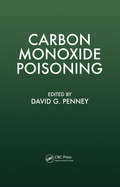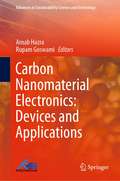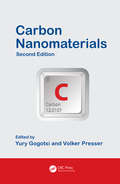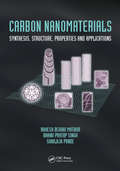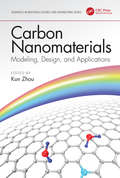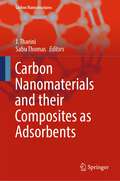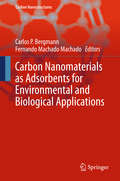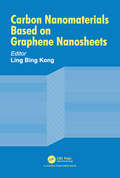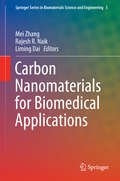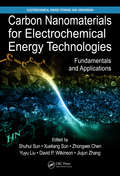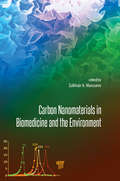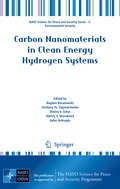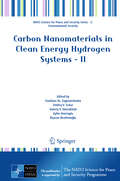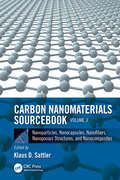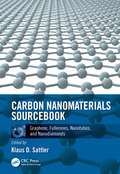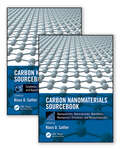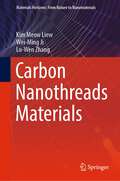- Table View
- List View
Carbon Monoxide Poisoning
by David G. PenneyWhile an ever-present and familiar toxin, carbon monoxide (CO) remains the number one poison in our environment. This silent killer is responsible for over 2,000 deaths a year in the United States alone. The public and healthcare communities need quality information about the many risks presented by carbon monoxide exposure. Edited by a leading e
Carbon Monoxide Toxicity
by David G. PenneyPublic interest in the health impacts of carbon monoxide (CO) has been increasing rapidly during the past decade. And rightly so: it is the most ubiquitous environmental poison. Car exhaust fumes, furnaces, gas-powered engines, home water heaters, smoke from all types of fire, and tobacco smoke all contribute to carbon monoxide intoxication - the l
Carbon Nanomaterial Electronics: Devices and Applications (Advances in Sustainability Science and Technology)
by Arnab Hazra Rupam GoswamiThis book brings together selective and specific chapters on nanoscale carbon and applications, thus making it unique due to its thematic content. It provides access to the contemporary developments in carbon nanomaterial research in electronic applications. Written by professionals with thorough expertise in similar broad area, the book is intended to address multiple aspects of carbon research in a single compiled edition. It targets professors, scientists and researchers belonging to the areas of physics, chemistry, engineering, biology and medicine, and working on theory, experiment and applications of carbon nanomaterials.
Carbon Nanomaterials: Second Edition
by Yury Gogotsi Volker PresserThis book provides information on synthesis, properties, and applications of carbon nanomaterials. With novel materials, such as graphene (atomically flat carbon) or carbon onions (carbon nanospheres), the family of carbon nanomaterials is rapidly growing. This book provides a state-of-the-art overview and in-depth analysis of the most important ca
Carbon Nanomaterials: Synthesis, Structure, Properties and Applications
by Rakesh Behari Mathur Bhanu Pratap Singh Shailaja PandeThe study of nanostructures has become, in recent years, a theme common to many disciplines, in which scientists and engineers manipulate matter at the atomic and molecular level in order to obtain materials and systems with significantly improved properties. Carbon nanomaterials have a unique place in nanoscience owing to their exceptional thermal, electrical, chemical, and mechanical properties, finding application in areas as diverse as super strong composite materials, energy storage and conversion, supercapacitors, smart sensors, targeted drug delivery, paints, and nanoelectronics. This book is the first to cover a broad spectrum of carbon nanomaterials, namely carbon nanofibers, vapor-grown carbon fibers, different forms of amorphous nanocarbons besides carbon nanotubes, fullerenes, graphene, graphene nanoribbons, graphene quantum dots, etc. in a single volume.
Carbon Nanomaterials: Synthesis, Structure, Properties and Applications
by Rakesh Behari Mathur Bhanu Pratap Singh Shailaja PandeThe study of nanostructures has become, in recent years, a theme common to many disciplines, in which scientists and engineers manipulate matter at the atomic and molecular level in order to obtain materials and systems with significantly improved properties. Carbon nanomaterials have a unique place in nanoscience owing to their exceptional thermal, electrical, chemical, and mechanical properties, finding application in areas as diverse as super strong composite materials, energy storage and conversion, supercapacitors, smart sensors, targeted drug delivery, paints, and nanoelectronics. This book is the first to cover a broad spectrum of carbon nanomaterials, namely carbon nanofibers, vapor-grown carbon fibers, different forms of amorphous nanocarbons besides carbon nanotubes, fullerenes, graphene, graphene nanoribbons, graphene quantum dots, etc. in a single volume.
Carbon Nanomaterials: Modeling Design And Applications (Advances in Materials Science and Engineering)
by Kun ZhouCarbon Nanomaterials: Modeling, Design, and Applications provides an in-depth review and analysis of the most popular carbon nanomaterials, including fullerenes, carbon nanotubes, graphene and novel carbon nanomaterial-based membranes and thin films, with emphasis on their modeling, design and applications. This book provides basic knowledge of the structures, properties and applications of carbon-based nanomaterials. It illustrates the fundamental structure-property relationships of the materials in both experimental and modeling aspects, offers technical guidance in computational simulation of nanomaterials, and delivers an extensive view on current achievements in research and practice, while presenting new possibilities in the design and usage of carbon nanomaterials. This book is aimed at both undergraduate and graduate students, researchers, designers, professors, and professionals within the fields of materials science and engineering, mechanical engineering, applied physics, and chemical engineering.
Carbon Nanomaterials and their Composites as Adsorbents (Carbon Nanostructures)
by Sabu Thomas J. ThariniThis book elucidates fundamental concepts of nanomaterials and their pivotal role as nanoadsorbents in water purification. Key features include the latest trends in adsorption for metal, micro pollutants, food adulterants, aromatic compounds, pesticides, dyes, and oil particle removal. Additionally, the interdisciplinary aspects of adsorption and practical applications for hazardous chemical removal from water are explored. The book delves into various types of adsorption isotherms such as Langmuir, Freundlich, BET, and others, offering a deep understanding for water purification. Kinetic models including first, second, and third order kinetics are elucidated, empowering undergraduate students to grasp and optimize complex systems. The required background is basic knowledge in chemistry, biology, mathematics, and nanoscience at the first-year university level. Designed for both academics and industrial researchers, this book is divided into 17 chapters. Chapters 1-7 introduce nanomaterials, carbon nanoadsorbents, their synthesis, and surface modification. Chapters 8-9 cover fundamental adsorption isotherms, kinetic models, thermodynamic parameters, adsorption mechanism, and experimental techniques. Chapters 10-15 delve into the adsorption and desorption of various compounds like aromatic compounds, pesticides, heavy metals, micro pollutants, food adulterants, oil particles, and dyes molecules. The final chapter tackles the theoretical modeling of carbon nanomaterials for adsorption studies
Carbon Nanomaterials as Adsorbents for Environmental and Biological Applications (Carbon Nanostructures)
by Carlos P. Bergmann Fernando Machado MachadoThis book presents a summary of the current use of carbon nanomaterials for water treatment, drug delivery, systems and nanosensors. The first chapter elucidates the adsorption process phenomenon. Also, the properties of different carbon nanomaterials for adsorption applications are covered. The third chapter presents the kinetic and equilibrium models of adsorption, processing of experimental data and adsorption process peculiarities. Environmental and biological applications of carbon nanomaterials are listed in the last chapter. This book is written from an application-oriented perspective and is useful for all those interested in nanoadsorbents.
Carbon Nanomaterials Based on Graphene Nanosheets
by Ling Bing KongSince the discovery of graphene, it has become one of the most widely and extensively studied materials. This book aims to summarize the progress in synthesis, processing, characterization and applications of a special group of nanocarbon materials derived from graphene or graphene related derivatives by using various strategies in different forms. More specifically, three forms of macrosized materials are presented, i.e., one-dimension or 1D (fibers, wires, yarns, streads, etc.), two-dimension or 2D (films, membranes, papers, sheets, etc.) and three-dimension or 3D (bulk, hydrogels, aerogels, foams, sponges, etc.). Seven chapters are included with the first chapter serving to introduce the concept, definition, and nomenclature of graphene, graphene oxide and their derivatives. The main topics are covered in Chapters 2‒7. Although they have coherent connections, each chapter of them is designed such that they can be studied independently. The target readers of this book include undergraduate students, postgraduate students, researchers, designers, engineers, professors, and program/project managers from the fields of materials science and engineering, applied physics, chemical engineering, biomaterials, materials manufacturing and design, institutes, and research founding agencies.
Carbon Nanomaterials Based on Graphene Nanosheets
by Ling Bing KongSince the discovery of graphene, it has become one of the most widely and extensively studied materials. This book aims to summarize the progress in synthesis, processing, characterization and applications of a special group of nanocarbon materials derived from graphene or graphene related derivatives by using various strategies in different forms. More specifically, three forms of macrosized materials are presented, i.e., one-dimension or 1D (fibers, wires, yarns, streads, etc.), two-dimension or 2D (films, membranes, papers, sheets, etc.) and three-dimension or 3D (bulk, hydrogels, aerogels, foams, sponges, etc.). Seven chapters are included with the first chapter serving to introduce the concept, definition, and nomenclature of graphene, graphene oxide and their derivatives. The main topics are covered in Chapters 2‒7. Although they have coherent connections, each chapter of them is designed such that they can be studied independently. The target readers of this book include undergraduate students, postgraduate students, researchers, designers, engineers, professors, and program/project managers from the fields of materials science and engineering, applied physics, chemical engineering, biomaterials, materials manufacturing and design, institutes, and research founding agencies.
Carbon Nanomaterials for Biomedical Applications (Springer Series in Biomaterials Science and Engineering #5)
by Mei Zhang Rajesh R. Naik Liming DaiThis book covers a wide range of topics relating to carbon nanomaterials, from synthesis and functionalization to applications in advanced biomedical devices and systems. As they possess unique and attractive chemical, physical, optical, and even magnetic properties for various applications, considerable effort has been made to employ carbon nanomaterials (e.g., fullerenes, carbon nanotubes, graphene, nanodiamond) as new materials for the development of novel biomedical tools, such as diagnostic sensors, imaging agents, and drug/gene delivery systems for both diagnostics and clinical treatment. Tremendous progress has been made and the scattered literature continues to grow rapidly.With chapters by world-renowned experts providing an overview of the state of the science as well as an understanding of the challenges that lie ahead, Carbon Nanomaterials for Biomedical Applications is essential reading not only for experienced scientists and engineers in biomedical and nanomaterials areas, but also for graduate students and advanced undergraduates in materials science and engineering, chemistry, and biology.
Carbon Nanomaterials for Electrochemical Energy Technologies: Fundamentals and Applications (Electrochemical Energy Storage and Conversion)
by Shuhui Sun Xueliang Sun Zhongwei Chen Yuyu Liu David P. Wilkinson Jiujun ZhangThis book offers comprehensive coverage of carbon-based nanomaterials and electrochemical energy conversion and storage technologies such as batteries, fuel cells, supercapacitors, and hydrogen generation and storage, as well as the latest material and new technology development. It addresses a variety of topics such as electrochemical processes, materials, components, assembly and manufacturing, degradation mechanisms, challenges, and strategies. With in-depth discussions ranging from electrochemistry fundamentals to engineering components and applied devices, this all-inclusive reference offers a broad view of various carbon nanomaterials and technologies for electrochemical energy conversion and storage devices.
Carbon Nanomaterials for Electrochemical Energy Technologies: Fundamentals and Applications (Electrochemical Energy Storage and Conversion)
by Shuhui Sun Xueliang Sun Zhongwei Chen Yuyu Liu David P. Wilkinson Jiujun ZhangThis book offers comprehensive coverage of carbon-based nanomaterials and electrochemical energy conversion and storage technologies such as batteries, fuel cells, supercapacitors, and hydrogen generation and storage, as well as the latest material and new technology development. It addresses a variety of topics such as electrochemical processes, materials, components, assembly and manufacturing, degradation mechanisms, challenges, and strategies. With in-depth discussions ranging from electrochemistry fundamentals to engineering components and applied devices, this all-inclusive reference offers a broad view of various carbon nanomaterials and technologies for electrochemical energy conversion and storage devices.
Carbon Nanomaterials in Biomedicine and the Environment
by Zulkhair MansurovCarbon nanomaterials possess special physical and chemical properties. As adsorbents, they are widely used for the purification of water and other liquids, recovery of valuable substances from liquid and gaseous media, and oil refining and also in petrochemical, wine, oil and fat, and other industries. They can be used in medicine, both for the creation of hemosorption systems that are capable of performing specific purification of blood and other physiological fluids, including removal of various exo- and endotoxicants, and for the construction of highly effective adsorbed probiotics.The creation of nanostructured carbon-containing materials is one of many rapidly developing research fields and also the theme of this book. The book focuses on the recent developments in the synthesis of nanostructured carbon multifunctional sorbents and covers topics such as fusicoccin compounds as anticancer agents, entero- and vulnerosorption, and blood purification. It will be useful for scientists, chemical industry specialists, professors, and master’s and PhD students of chemical, physical, and biological sciences.
Carbon Nanomaterials in Biomedicine and the Environment
by Zulkhair A. MansurovCarbon nanomaterials possess special physical and chemical properties. As adsorbents, they are widely used for the purification of water and other liquids, recovery of valuable substances from liquid and gaseous media, and oil refining and also in petrochemical, wine, oil and fat, and other industries. They can be used in medicine, both for the creation of hemosorption systems that are capable of performing specific purification of blood and other physiological fluids, including removal of various exo- and endotoxicants, and for the construction of highly effective adsorbed probiotics.The creation of nanostructured carbon-containing materials is one of many rapidly developing research fields and also the theme of this book. The book focuses on the recent developments in the synthesis of nanostructured carbon multifunctional sorbents and covers topics such as fusicoccin compounds as anticancer agents, entero- and vulnerosorption, and blood purification. It will be useful for scientists, chemical industry specialists, professors, and master’s and PhD students of chemical, physical, and biological sciences.
Carbon Nanomaterials in Clean Energy Hydrogen Systems (NATO Science for Peace and Security Series C: Environmental Security)
by Bogdan Baranowski Svetlana Zaginaichenko Dmitry Schur Valeriy Skorokhod Ayfer VezirogluThe 2007 ARW “Using Carbon Nanomaterials in Clean-Energy Hydrogen Systems” (UCNCEHS’2007) was held in September 22–28, 2007 in the remarkable town Sudak (Crimea, Ukraine) known for its heroic and unusual fate. In the tradition of the earlier conferences, UCNCEHS’2007 meeting served as an multidisciplinary forum for the presentation and discussion of the most recent research on transition to hydrogen-based energy systems, technologies for hydrogen production, storage, utilization, carbon nanomaterials processing and chemical behavior, energy and environmental problems. The aim of UCNCEHS’2007 was to provide the wide overview of the latest scientific results on basic research and technological applications of hydrogen interactions with carbon materials. The active representatives from research/academic organizations and governmental agencies could meet, discuss and present the most recent advances in hydrogen concepts, processes and systems, to evaluate current progress and to exchange academic information, to identify research needs and future development in this important area. This ARW should help further the progress of hydrogen-based science and promote the role of hydrogen and carbon nanomaterials in the energy field.
Carbon Nanomaterials in Clean Energy Hydrogen Systems - II (NATO Science for Peace and Security Series C: Environmental Security)
by Svetlana Yu. Yu. Zaginaichenko, Dmitry V. V. Schur, Valeriy V. V. Skorokhod, Ayfer Veziroglu and Beycan İbrahimoğluThis book presents selected contributions to the NATO Advanced Research Workshop “Carbon Nanomaterials in Clean Energy Hydrogen Systems” held in June 2010. These original papers reflect recent progress in response to the modern-day requirements in chemistry of carbon nanomaterials and metal-hydrogen systems. Successor to the 2008 proceedings, this second volume focuses on research and application studies of materials capable of interacting actively with hydrogen, also addressing questions of hydrogen accumulation and storage. As a whole, it provides a review of the most relevant areas of hydrogen materials interactions and carbon nanomaterials science, making it invaluable for all researchers, physicists, chemists, post-graduates and young scientists interested in the structure, properties and applications of different nanocarbon materials.
Carbon Nanomaterials: Modeling, Design, and Applications (Advances in Materials Science and Engineering)
by Kun ZhouCarbon Nanomaterials: Modeling, Design, and Applications provides an in-depth review and analysis of the most popular carbon nanomaterials, including fullerenes, carbon nanotubes, graphene and novel carbon nanomaterial-based membranes and thin films, with emphasis on their modeling, design and applications. This book provides basic knowledge of the structures, properties and applications of carbon-based nanomaterials. It illustrates the fundamental structure-property relationships of the materials in both experimental and modeling aspects, offers technical guidance in computational simulation of nanomaterials, and delivers an extensive view on current achievements in research and practice, while presenting new possibilities in the design and usage of carbon nanomaterials. This book is aimed at both undergraduate and graduate students, researchers, designers, professors, and professionals within the fields of materials science and engineering, mechanical engineering, applied physics, and chemical engineering.
Carbon Nanomaterials Sourcebook: Nanoparticles, Nanocapsules, Nanofibers, Nanoporous Structures, and Nanocomposites, Volume II
by Klaus D. SattlerThe Carbon Nanomaterials Sourcebook contains extensive, interdisciplinary coverage of carbon nanomaterials, encompassing the full scope of the field—from physics, chemistry, and materials science to molecular biology, engineering, and medicine—in two comprehensive volumes. Written in a tutorial style, this second volume of the sourcebook: Focuses on nanoparticles, nanocapsules, nanofibers, nanoporous structures, and nanocomposites Describes the fundamental properties, growth mechanisms, and processing of each nanomaterial discussed Explores functionalization for electronic, energy, biomedical, and environmental applications Showcases materials with exceptional properties, synthesis methods, large-scale production techniques, and application prospects Provides the tools necessary for understanding current and future technology developments, including important equations, tables, and graphs Each chapter is dedicated to a different type of carbon nanomaterial and addresses three main areas: formation, properties, and applications. This setup allows for quick and easy search, making the Carbon Nanomaterials Sourcebook: Nanoparticles, Nanocapsules, Nanofibers, Nanoporous Structures, and Nanocomposites a must-have reference for scientists and engineers.
Carbon Nanomaterials Sourcebook: Graphene, Fullerenes, Nanotubes, and Nanodiamonds, Volume I
by Klaus D. SattlerThe Carbon Nanomaterials Sourcebook contains extensive, interdisciplinary coverage of carbon nanomaterials, encompassing the full scope of the field-from physics, chemistry, and materials science to molecular biology, engineering, and medicine-in two comprehensive volumes.Written in a tutorial style, this first volume of the sourcebook:Focuses on g
Carbon Nanomaterials Sourcebook: Nanoparticles, Nanocapsules, Nanofibers, Nanoporous Structures, and Nanocomposites, Volume II
by Klaus D. SattlerThe Carbon Nanomaterials Sourcebook contains extensive, interdisciplinary coverage of carbon nanomaterials, encompassing the full scope of the field—from physics, chemistry, and materials science to molecular biology, engineering, and medicine—in two comprehensive volumes. Written in a tutorial style, this second volume of the sourcebook: Focuses on nanoparticles, nanocapsules, nanofibers, nanoporous structures, and nanocomposites Describes the fundamental properties, growth mechanisms, and processing of each nanomaterial discussed Explores functionalization for electronic, energy, biomedical, and environmental applications Showcases materials with exceptional properties, synthesis methods, large-scale production techniques, and application prospects Provides the tools necessary for understanding current and future technology developments, including important equations, tables, and graphs Each chapter is dedicated to a different type of carbon nanomaterial and addresses three main areas: formation, properties, and applications. This setup allows for quick and easy search, making the Carbon Nanomaterials Sourcebook: Nanoparticles, Nanocapsules, Nanofibers, Nanoporous Structures, and Nanocomposites a must-have reference for scientists and engineers.
Carbon Nanomaterials Sourcebook, Two-Volume Set
by Klaus D. SattlerThis two-volume sourcebook is the most comprehensive reference for carbon nanomaterials, bringing together the physics, chemistry, materials science, molecular biology and engineering of all carbon nanomaterial types that are important in electronics, energy, biomedical and environmental applications. Each chapter addresses the fundamental properties, growth mechanisms, processing and functionalization of a particular nanocarbon. The first volume covers graphene, fullerenes, nanotubes and nanodiamonds. The second volume focuses on nanoparticles, nanocapsules, nanofibers, nanoporous structures and nanocomposites.
Carbon Nanostructured Materials: Synthesis, Characterization, and Industrial Applications (SpringerBriefs in Materials)
by Maksym Barabash Alexander Khovavko Eugene Strativnov Andrii Nebesnyi Denis Filonenko Olexiy Sviatenko Angela PiatovaThis book provides a concise yet comprehensive look at carbon nanostructured materials, focusing on synthesis methodologies, applications, and fundamental principles. Based on extensive research conducted at the Gas Institute of the National Academy of Sciences of Ukraine, it offers a thorough examination of recent advancements in the field. The book describes various synthesis techniques, particularly emphasizing the continuous synthesis of carbon nanotubes (CNTs) on metal catalysts using chemical vapor deposition (CVD). It also discusses computational fluid dynamics (CFD) modeling of heating processes associated with carbon materials, crucial for understanding the thermodynamics of complex gas systems relevant to CNTs synthesis. Furthermore, the book discusses the structural properties of carbon nanomaterials, employing techniques such as Raman spectroscopy and optical microscopy. It provides detailed insights into the design and optimization of modern equipment for CNTs synthesis, with a focus on energy-efficient reactors for thermally expanded graphite (TEG) production. Beyond synthesis methodologies, the book explores applications of carbon nanomaterials, including their use in lithium-ion batteries, water purification systems, and nuclear reactors. It offers a serious examination of the potential environmental and technological implications of these materials. Comprising three distinct parts, each supplemented with comprehensive summaries, this book serves as a valuable resource for researchers, engineers, and graduate students in material science, thermal engineering, and nanotechnology. It presents empirical findings, theoretical insights, and practical applications, establishing itself as a valuable addition to the literature in the field of carbon nanostructured materials.
Carbon Nanothreads Materials (Materials Horizons: From Nature to Nanomaterials)
by Kim Meow Liew Wei-Ming Ji Lu-Wen ZhangThis book describes carbon nanothreads with complete and comprehensive knowledge covering theories, numerical methods, and properties comparisons with other carbon-based nanomaterials. For one thing, the main theoretical aspects in this book include: First-Principle Calculation, Density Functional Theory, Classical Molecular Dynamics Simulation, Non-equilibrium Molecular Dynamics Simulation, and Coarse Grained Simulation. For another thing, the main research contents include: Fundamental Mechanical Properties; Fracture Characteristics; Electronic and Magnetic Properties; Thermal Properties; Reinforcement in Polymer Composites; and other promising applications in engineering. The target of this book is to provide to many researchers the available theoretical and numerical methods, and useful computational results of carbon nanothreads for reference. This book can be used as a comprehensive source for scientists, academics, researchers, and engineers in various areas of engineering, physical sciences, and computational modeling. In order to achieve this target, the book introduces the microstructure information of carbon nanothreads and the modeling details at full length. The tunable mechanisms of physical properties of carbon nanothreads are discussed in detail, which enable integration of these nanoscale components into high-order structures for “bottom-up design” purpose. The revealed reinforced mechanisms of carbon nanothreads in polymer composites can provide theoretical guidance for engineering design of advanced polymer composites.
